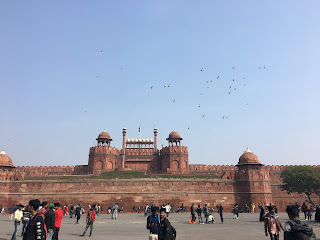1. Gurdwara Nanak Piao
This asthan is built at the site, in the garden where Guru Nanak Dev Ji Mahraj camped when they visited Delhi in 1505 during the reign of Sultan Sikander Shah Lodhi. Guru Ji used to offer food and water to the hungry and thirsty here, hence the name of the shrine. The word "Piao" mean to "offer something to drink" and refers to the offering of water to all the thirsty who visited this shrine. The well used by Guru Ji is preserved here.
2. Gurdwara Sri Majnu Ka Tila Sahib
Majnu Ka Tila, meaning the hillock of Majnu was visited by both Guru Nanak Dev Ji Maharaj and Guru Hargobind Ji Mahraj. Here used to live a Muslim ascetic who was popularly known as Majnu (the nickname Persians had given to a young man whose never ending love of a girl (Lali) became symbolic of the intense mysticical love for God of Sufi literature). The Yamuna's Majnu, when not lost in meditation, would use his small boat to ferry people across the Yamuna for free. After doing darshan of Guru Nanak Dev Ji, attaining the enlightenment he had so long sought, Majnu became a devout Sikh of the great Guru. While Guru Nanak Dev Ji was camping atop this hillock many Sufi saints of Delhi came to held spiritual discussions with them. Guru Hargobind Ji Mahraj is also said to have visited this asthan on their way to and back from Gwalior prison.
3. Gurdwara Bangla Sahib
Gurdwara Bangla Sahib was originally a bungalow belonging to Raja Jai Singh. Guru Har Krishan Ji resided here during their stay in Delhi. At that time, there was a small pox epidemic, and Guru Har Krishan Ji helped the suffering of Sanggat by giving aid and fresh water from the well at this house.
4. Gurdwara Sri Bala Sahib
Guru Harkrishan Sahib having taken the burden and sufferings of others on their own shoulders, amidst of the smallpox epidemic moved from the bungalow of Raja Jai Singh to this spot at the bank of Yamuna river where Sikhs pitched a large tent. Guru Harkrishan Ji informed the Sanggat that that were going to leave for Sach Khand and it was also here where they indicated the next Guru is in Bakala. Guru Ji was cremated here.
5. Gurdwara Mata Sundri Ji
This was the last home of Mata Sundri Ji where she nurtured and guided the Khalsa Panth after Guru Gobind Singh Ji left for Sachkhand. It was from this place that Mata Ji appointed Bhai Mani Singh Ji as the Head Granthi of Sri Harmandar Sahib, Amritsar. Mata Sundri Ji left her physical body at this place and the cremation was carried out at the site of Gurdwara Sri Bala Sahib.
6. . Gurdwara Sri Sis Ganj Sahib
This marks the spot where Guru Tegh Bahadur Ji Maharaj attained Shaheedi. The spot of the execution was under a Banyan tree (the trunk of the tree and a well nearby where Guru Ji did ishnaan from are still preserved).
7. Gurdwara Sri Rakab Ganj Sahib
This Gurdwara marks the site, where Lakhi Shah Vanjara and other Lubana Sikhs burnt their own house to cremate the body of Guru Tegh Bahadur Ji Mahraj.
6. Gurdwara Moti Bagh Sahib
Sri Guru Gobind Singh Ji Mahraj camped at this site with their army upon arriving in Delhi. Guru Ji, an accomplished archer, shot two arrows from this asthan which hit the Divan (throne) at the Red Fort. Guru Ji's first arrow announced their arrival in Delhi and the second arrow carried a chit saying, "It is not magic but skill of archery". Bahadur Shah was said to be sitting in the Red Fort at the time. Seeing the arrow strike, Bahadur Shah initially took this as a miracle but looking at the second arrow landed in the Divan's left foot with a note pointing out that the Emperor was wrong in labelling the sudden appearance of an arrow in his fort as a miracle. The Emperor was said to be so impressed with this that he immediately acknowledged Guru Sahib's supremacy. The deohri from where Guru Gobind Singh shot the arrows is located here where one can climb up to.
9. Gurdwara Sri Damdama Sahib
Gurdwara Sri Damdama Sahib, located near Humayun's Tomb commemorates Sri Guru Gobind Singh Ji's meeting with Emperor Bahadur Shah I in 1707 who asked the help of Guru Mahraj in his battle for succession for the throne with his brother, after the death of Aurangzeb.
10. Gurdwara Sri Shaheedi Asthan Baba Banda Singh Bahadur
This spot is where Baba Banda Singh Bahadur, his 4 year old son, Ajai Singh, along with other Sikhs were tortured and executed by order of the Mughal ruler Farrukh Siyar in 1716. A 50-foot high pillar of stone still has the steel hook from which, it is believed, Baba Banda Singh Bahadur was hung and tortured.















































